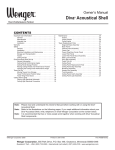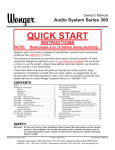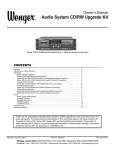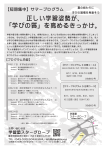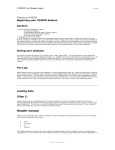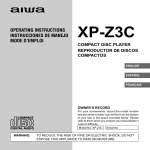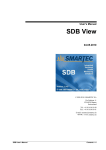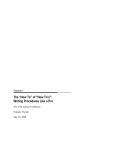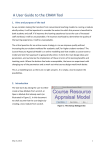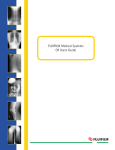Download Wenger VAE User`s guide
Transcript
User's Guide Lexicon® technology IMPORTANT SAFETY INSTRUCTIONS WARNING FOR YOUR PROTECTION READ THESE INSTRUCTIONS: KEEP THESE INSTRUCTIONS HEED ALL WARNINGS FOLLOW ALL INSTRUCTIONS The symbols shown above are internationally accepted symbols that warn of potential hazards with electrical products. The lightning flash with arrowpoint in an equilateral triangle means that there are dangerous voltages present within the unit. The exclamation point in an equilateral triangle indicates that it is necessary for the user to refer to the owner’s manual. These symbols warn that there are no user serviceable parts inside the unit. Do not open the unit. Do not attempt to service the unit yourself. Refer all servicing to qualified personnel. Opening the chassis for any reason will void the manufacturer’s warranty. Do not get the unit wet. If liquid is spilled on the unit, shut it off immediately and take it to a dealer for service. Disconnect the unit during storms to prevent damage. Do not use this apparatus near water The apparatus shall not be exposed to dripping or splashing liquid and no object filled with liquid, such as vases, shall be placed on the apparatus. CLEAN ONLY WITH A DRY CLOTH. DO NOT BLOCK ANY OF THE VENTILATION OPENINGS. INSTALL IN ACCORDANCE WITH THE MANUFACTURER’S INSTRUCTIONS. DO NOT INSTALL NEAR ANY HEAT SOURCES SUCH AS RADIATORS, HEAT REGISTERS, STOVES, OR OTHER APPARATUS (INCLUDING AMPLIFIERS) THAT PRODUCE HEAT. ONLY USE ATTACHMENTS/ACCESSORIES SPECIFIED BY THE MANUFACTURER. UNPLUG THIS APPARATUS DURING LIGHTNING STORMS OR WHEN UNUSED FOR LONG PERIODS OF TIME. Safety Instructions Notice For Customers If Your Unit Is Equipped With A Power Cord. WARNING: THIS APPLIANCE MUST BE EARTHED. Connect only to a mains socket outlet with protective earthing connection. The cores in the mains lead are coloured in accordance with the following code: GREEN and YELLOW - Earth BLUE - Neutral BROWN - Live As colours of the cores in the mains lead of this appliance may not correspond with the coloured markings identifying the terminals in your plug, proceed as follows: The core which is coloured green and yellow must be connected to the terminal in the plug marked with the letter E, or with the earth symbol, or coloured green, or green and yellow. • The core which is coloured blue must be connected to the terminal marked N or coloured black. • The core which is coloured brown must be connected to the terminal marked L or coloured red. Do not defeat the safety purpose of the polarized or grounding-type plug. A polarized plug has two blades with one wider than the other. A grounding type plug has two blades and a third grounding prong. The wide blade or third prong are provided for your safety. If the provided plug does not fit your outlet, consult an electrician for replacement of the obsolete outlet. Protect the power cord from being walked on or pinched particularly at plugs, convenience receptacles, and the point where they exit from the apparatus. Use only with the cart stand, tripod bracket, or table specified by the manufacturer, or sold with the apparatus. When a cart is used, use caution when moving the cart/apparatus combination to avoid injury from tip-over. • This equipment may require the use of a different line cord, attachment plug, or both, depending on the available power source at installation. If the attachment plug needs to be changed, refer servicing to qualified service personnel who should refer to the table below. The green/yellow wire shall be connected directly to the units chassis. Refer all servicing to qualified service personnel. Servicing is required when the apparatus has been damaged in any way, such as power-supply cord or plug is damaged, liquid has been spilled or objects have fallen into the apparatus, the apparatus has been exposed to rain or moisture, does not operate normally, or has been dropped. POWER ON/OFF SWITCH: For products provided with a power switch, the power switch DOES NOT break the connection from the mains. MAINS DISCONNECT: The plug shall remain readily operable. For rackmount or installation where plug is not accessible, an all-pole mains switch with a contact separation of at least 3 mm in each pole shall be incorporated into the electrical installation of the rack or building. FOR UNITS EQUIPPED WITH EXTERNALLY ACCESSIBLE FUSE RECEPTACLE: Replace fuse with same type and rating only. WARNING: If the ground is defeated, certain fault conditions in the unit or in the system to which it is connected can result in full line voltage between chassis and earth ground. Severe injury or death can then result if the chassis and earth ground are touched simultaneously. MULTIPLE-INPUT VOLTAGE: This equipment may require the use of a different line cord, attachment plug, or both, depending on the available power source at installation. Connect this equipment only to the power source indicated on the equipment rear panel. To reduce the risk of fire or electric shock, refer servicing to qualified service personnel or equivalent. This Equipment is intended for rack mount use only. Section Title IMPORTANT SAFETY INSTRUCTIONS ELECTROMAGNETIC COMPATIBILITY This unit conforms to the Product Specifications noted on the Declaration of Conformity. Operation is subject to the following two conditions: this device may not cause harmful • interference, and this device must accept any interference • received, including interference that may cause undesired operation. Operation of this unit within significant electromagnetic fields should be avoided. use only shielded interconnecting cables. • U.K. MAINS PLUG WARNING A molded mains plug that has been cut off from the cord is unsafe. Discard the mains plug at a suitable disposal facility. NEVER UNDER ANY CIRCUMSTANCES SHOULD YOU INSERT A DAMAGED OR CUT MAINS PLUG INTO A 13 AMP POWER SOCKET. Do not use the mains plug without the fuse cover in place. Replacement fuse covers can be obtained from your local retailer. Replacement fuses are 13 amps and MUST be ASTA approved to BS1362. Rack Spacing Requirement The model LHD240 VAE main unit must be mounted with a minimum of 1.5 inches (1U rack space) of space above and below it for proper air ventilation. Service Info/Warranty Service Info If you require technical support, contact Wenger Corp. Customer Service at 1-800-887-7145. Warranty This warranty is valid only for the original purchaser. 1.Wenger Corp. warrants this product to be free from defects in materials and workmanship under normal use and service. 3.Wenger Corp.'s liability under this warranty is limited to repairing or, at our discretion, replacing defective materials that show evidence of defect. All parts and labor will be covered up to a period of 5 years. 4.Wenger Corp. reserves the right to make changes in design or make additions to or improvements upon this product without incurring any obligation to install the same additions or improvements on products previously manufactured. 5.The foregoing is in lieu of all other warranties, expressed or implied, and Wenger Corp. neither assumes nor authorizes any person to assume on its behalf any obligation or liability in connection with the sale of this product. In no event shall Wenger Corp. be liable for special or consequential damages or from any delay in the performance of this warranty due to causes beyond its control. Table of Contents Table of Contents Service Info. . . . . . . . . . . . . . . . . . . . . . . . . . . . . . . . . . . . . . . . . . . . . . . . . . . . . . . . . . . . . 4 Introduction. . . . . . . . . . . . . . . . . . . . . . . . . . . . . . . . . . . . . . . . . . . . . . . . . . . . . . . . . . . . 6 Welcome . . . . . . . . . . . . . . . . . . . . . . . . . . . . . . . . . . . . . . . . . . . . . . . . . . . . . . . . . . . 6 Features - Acoustic Environments. . . . . . . . . . . . . . . . . . . . . . . . . . . . . . . . . . . . . . . 6 Features - Recording/Playback . . . . . . . . . . . . . . . . . . . . . . . . . . . . . . . . . . . . . . . . . 7 The Keypad. . . . . . . . . . . . . . . . . . . . . . . . . . . . . . . . . . . . . . . . . . . . . . . . . . . . . . . . . . . . . 8 Diagram . . . . . . . . . . . . . . . . . . . . . . . . . . . . . . . . . . . . . . . . . . . . . . . . . . . . . . . . . . . 8 User Connections. . . . . . . . . . . . . . . . . . . . . . . . . . . . . . . . . . . . . . . . . . . . . . . . . . . . . . . 10 Using the VAE. . . . . . . . . . . . . . . . . . . . . . . . . . . . . . . . . . . . . . . . . . . . . . . . . . . . . . . . . . 11 Selecting a Room. . . . . . . . . . . . . . . . . . . . . . . . . . . . . . . . . . . . . . . . . . . . . . . . . . . 11 Adjusting Volume. . . . . . . . . . . . . . . . . . . . . . . . . . . . . . . . . . . . . . . . . . . . . . . . . . . 12 Mute. . . . . . . . . . . . . . . . . . . . . . . . . . . . . . . . . . . . . . . . . . . . . . . . . . . . . . . . . . . . . . 12 Selecting a Session. . . . . . . . . . . . . . . . . . . . . . . . . . . . . . . . . . . . . . . . . . . . . . . . . . 13 Recording . . . . . . . . . . . . . . . . . . . . . . . . . . . . . . . . . . . . . . . . . . . . . . . . . . . . . . . . . 13 Playback . . . . . . . . . . . . . . . . . . . . . . . . . . . . . . . . . . . . . . . . . . . . . . . . . . . . . . . . . . 13 External Connections. . . . . . . . . . . . . . . . . . . . . . . . . . . . . . . . . . . . . . . . . . . . . . . . . . . . 14 USB . . . . . . . . . . . . . . . . . . . . . . . . . . . . . . . . . . . . . . . . . . . . . . . . . . . . . . . . . . . . . . 14 Record Output. . . . . . . . . . . . . . . . . . . . . . . . . . . . . . . . . . . . . . . . . . . . . . . . . . . . . . 14 Footswitch. . . . . . . . . . . . . . . . . . . . . . . . . . . . . . . . . . . . . . . . . . . . . . . . . . . . . . . . . 14 Specifications. . . . . . . . . . . . . . . . . . . . . . . . . . . . . . . . . . . . . . . . . . . . . . . . . . . . . . . . . . 15 Declaration of Conformity. . . . . . . . . . . . . . . . . . . . . . . . . . . . . . . . . . . . . . . . . . . . . . . . 16 Introduction Introduction Welcome Congratulations on your selection of the Virtual Acoustic Environments (VAE) system and welcome to a world of possibilities and inspiration. With this equipment you have enabled your music practice room to become the ultimate in rehearsal rooms. From a small recital room to a large auditorium or even a spacious cathedral, you can practice your musical talents in a wide variety of virtual performance spaces. With the push of a button, the VAE allows you to change your practice space into a wide variety of “live” performance spaces. The VAE system also allows you to capture and record your practice sessions giving you instant feedback on your performance. Musicians know that the acoustic space you play in affects the feel of a performance and that musical cues from the sound of their instrument in that space are an important part of optimizing the timing and feel of a performance. With the VAE Virtual Practice Room system you have full control of the acoustic space giving you the ability to match the sound of the space to your acoustic needs. This flexibility and the excitement it generates leads to motivation and inspiration in any musician. It has been said that “each musician is their own worst critic”. The ability to instantly hear back your practice session or performance is an important self-motivating tool for any musician to improve their capabilities. The session recording capabilities of the VAE system give you an easy way to record and play back your practice sessions. With the capability to record up to nine sessions and a simple user control interface that includes Record, Stop, Play, Fast Forward, and Rewind and a display showing the current session number and playback time, you have a complete self-critiquing solution at your fingertips. After you have captured your performance you may download a copy of the sound file to your own personal computer through the USB port. There is truly nothing like the VAE system in creating the optimal practice environment for musicians and giving them the tools they need to get the most from their practice sessions. Features - Acoustic Environments • Accurately emulates nine common performance spaces including: • Rooms (practice, Baroque) • Recital Halls (medium and large) • Auditoriums (large, medium, and small) • Special Spaces (Cathedral, Arena) • Patented LEXICON © Virtual Environment technology Introduction Features - recording/playback • Ability to Record and Playback Nine Sessions • Playback of Prerecorded Sessions • Intuitive Wall-Mounted Keypad Interface • Bright LED Display Shows: • Current Session Number • Record/Playback Time (Minutes and Seconds) • Nine-Button Listening Environment Select with LED Indicators • Adjustable Volume • Single-Button Mute with LED Indicator • Dedicated Recording Buttons Including: • Record Button with integrated Red LED indicator • Play Button with integrated Green LED indicator • Stop Button (Session Erase when button is held down) • Fast Forward and Rewind Buttons • Session Select Button • USB Connection for Retrieving Recorded Sessions • Remote Footswitch Connection for Remote Control: • Optional 3-Button Footswitch • Hands-Free Operation of Recording and Playback • Record, Play, Stop, Erase, and Restart Functions • Record-Out Jack for External Recording Equipment The Keypad The Keypad Diagram SESSION indicator This two-digit display shows which of the 9 possible session tracks is selected. This session will play or be recorded when the appropriate key is pressed. TIME indicator The four-digit display shows the elapsed time in seconds for playback or record files. If the selected session track is empty this display will show --:--.If the session is playing or recording, this display will show the elapsed time in minutes and seconds. STOP This button stops playback or record. In playback mode the session is stopped and may be started again at the same place. If playback is stopped and the STOP button is pressed again the session will rewind to the start. If the STOP button is pressed and held for two seconds, the current session is erased and the display will read --:--. RECORD This button starts recording of the selected session. Recording can only be initiated if the current session track is empty and the display reads --:--. Recording cannot be done while a USB connection is active. The Keypad PLAY This button will start play back of the selected session. The green LED on the button indicates that playback is active. Playback cannot be run while a USB connection is active. Rew Pressing this button while playing a session will cause the playback to skip backwards 10 seconds at a time. Pressing this button while playback is stopped will rewind the session start time in 10-second steps to any desired location. FWD Pressing this button while playing a session will cause the playback to skip forward 10 seconds at a time. Pressing this button while stopped will change the session start time in 10-second steps. Clear Pressing the REW and FWD buttons simultaneously (when not playing or recording) will clear the contents of the current session and the display will read --:--. SELECT This button will change the session number. Each time it is pressed the session number on the display increments. The time indicator will show the length of that session for about two seconds after the SELECT button is pressed and then reset to “00:00” awaiting commands to play or record from the beginning of the session. Performance Space Selection Buttons Pressing any one of these mutually exclusive buttons will change the Active Acoustics settings to the indicated performance space and light the corresponding LED. VOLUME UP This button will incrementally raise the system volume for Active Acoustics and playback. User Connections VOLUME DOWN This button will incrementally lower the system volume for Active Acoustics and playback. MUTE This button will mute the Active Acoustics coming from the system. Playback sound is not muted but can be stopped with the STOP button. User connections The USB connection This Type B connection is for output of the prerecorded files from the VAE memory to a PC. Connect a USB cable from a laptop computer to this jack and a removable disk will automatically be activated on the computer system. Any of the session files saved in the VAE memory can be copied onto the laptop. This function requires Windows® 98 second edition or higher along with the appropriate drivers. The Record output This 1/8” stereo jack is a 2-channel audio output of the sound in the room which can be used for external recording or headphones. The Footswitch connection This 1/4” TRS jack is a 3-wire connection to an optional Wenger footswitch. If the footswitch is connected then the STOP, RECORD and PLAY functions can be initiated from either the footswitch or the keypad. 10 Using the VAE Using the VAE Selecting a Room You have instant control over the type of room that you practice in. Feel free to try each of the nine virtual performance spaces to experience how they sound. They are arranged basically in order of room size, but the type of room makes a difference in the sound as well. Once a room type is selected, that selection will remain until another one is chosen. The room selection defaults to PRACTICE ROOM at power on. A complete description of each room type is given below. PRACTICE ROOM Modeled after the acoustics of a typical 8’ x 10’ music practice room with minimal acoustic treatment on the walls. BAROQUE ROOM A room with seating for up to 125, similar to the spaces in which music composed during the Baroque period was performed. This room is modeled after a typical ornate room of that era with hard walls, floors and high ceiling, giving it a characteristic brightness and envelopment. Since these rooms were quite reflective, they were also quite “loud” in comparison to larger spaces meant for greater numbers of performers. The live feel of this space is ideally suited for smaller arrangements as well as oratorios and instrumental concertos. MEDIUM RECITAL hall A modest-size recital hall with seating from 100 to 200 seats, providing an intimate performance space. These types of rooms are typically found in schools of music on college campuses with active music programs. This room is modeled after typical recital halls constructed of hard walls and ceilings with angled wood panels along the sidewalls and in the rear of the room providing diffusion to the space. Characteristics of these rooms are good clarity and warmth with smooth decay provided by nice, even diffusion of sound within the hall. LARGE RECITAL hall A larger recital hall, ranging from 350 to 500 seats. Halls like these are typically found on college campuses and intended for performances of larger groups. The hall is modeled after spaces with hard walls and high ceilings with the addition of diffusing wood panels along the side and back walls. In the ceiling area are reflective clouds to provide enhanced early reflections. Characteristics of this space are a bright sound with a smooth, longer decay of sound. SMALL AUDITORIUM A small auditorium space with seating for 500. Spaces like this are often found on college campuses, churches, and some civic facilities. Because many groups share them, these auditoriums are not necessarily dedicated for music performance. The space is modeled after typical construction of hard walls and ceilings with some absorption in the back of the room to prevent strong reflections back to the stage. The room has a small stage without a proscenium. Characteristics of these spaces include strong early reflections due to the smaller size, a bright sound and a relatively short decay to the sound. 11 Using the VAE MEDIUM AUDITORIUM A modest-size auditorium with 750 to 900 seats. These types of auditoriums are found in high schools, college campuses, churches, and as civic facilities in many communities. The medium auditorium is modeled after a space with hard walls and ceilings with absorption on the back wall to prevent strong reflections back to the stage. The room has a small proscenium stage with additional reflective surfaces located on the sidewalls in the ceiling area near the stage to improve early reflections and diffusion. The sound character of this space is a bright clear sound with a modest decay in the sound. LARGE AUDITORIUM A large space with 1,200 to 1,500 seats. These types of auditoriums are common in larger high schools, college schools of music, larger churches, performing arts centers, and civic facilities. It’s modeled with hard walls and ceilings, carpeted aisle ways, padded seating, and absorption on the back wall to prevent strong reflections back to the stage. The room has a large proscenium stage with sidewalls containing wood diffusing surfaces and additional reflective surfaces in the ceiling area near the stage. Characteristics of this space include a warm, enveloping sound yet still maintaining good clarity to the sound. There is a noticeably longer decay of sound. CATHEDRAL Large, rectangular stone cathedral with highly reflective stone walls along the sides providing early reflections. High ceilings and a long sanctuary contribute to a quick buildup of sound with a long decay. Choral, organ and soloists playing instruments with smooth attacks are highlighted in this room. ARENA Very large space with seating for 10,000. The space is modeled after typical indoor sports facilities found on larger college campuses and in larger cities. The characteristic sound of these spaces is dominated by hard surfaces with little absorption. Sidewalls are located some distance away, creating early reflections that are noticeably delayed. Sound decays very slowly in these types of spaces due to the size and larger area of hard reflecting surfaces. Adjusting Volume Press the Volume UP/DOWN buttons to adjust the volume as desired. This is normally only necessary for playback of your sessions as the volume level is preset for each performance space. There may be some cases when practicing with loud instruments that you may want to turn the volume down. These buttons only affect the volume level of playback if pressed during playback. If pressed when playback is stopped, they change the volume of the Active Acoustics. Mute Press the MUTE button to toggle on or off the Active Acoustics of the system. The corresponding LED shows if the sound of the Active Acoustics is off. When playback is started, the Active Acoustics is automatically muted to avoid double reverberation, but can be un-muted manually if desired. 12 Using the VAE Selecting a session Each time you record in the Virtual Practice Room it is saved as a session. There are 9 possible sessions that you can record to. To change the session, so that you do not record over a previously recorded session, use the SELECT button. Pressing the button will increment the session number as shown on the session display. It wraps around from 9 back to 1. As you change to a new session the time display will show the length of the session for two seconds and then it will show 00:00. If you wish to erase a previously recorded session, press the SELECT button until the correct session number is displayed and then press the REW and FWD (CLEAR) buttons simultaneously until the time display shows --:--. Pressing and holding the STOP button for two seconds will also clear the memory in the current session. Recording A very useful feature of the VAE is its digital recording capability. To record your session just choose a session number with the SELECT button and then press RECORD. Pressing the SELECT button will change the selected session number to the next higher number. The SELECT button will change the session display up to 9 and then wrap back to session 1. There is enough memory to record one hour of total session time. The total record time can be divided up in any way amongst sessions 1 thru 9. The display will show “FULL” if you try to record when there is no more memory. In this case, select a session you don't want to keep and simply erase it. While recording, the red LED on the “RECORD” button is illuminated and the TIME display will show the elapsed time from the start of recording. To stop recording, press the STOP button. The recorded session will remain in internal memory, even after power off, until cleared. Recording can also be done from the record output to any external record device. See the section on “RECORD OUTPUT” below. Playback After a session is recorded you can play it back at anytime. If you have just recorded a session, simply press PLAY and it will start playing from the beginning. You can select any of the 9 sessions to play by first pressing the SELECT button until the correct session number is shown on the display and then pressing PLAY. During playback the green LED on the button will illuminate and the elapsed time from the beginning of the session is continually updated. It will only playback what was previously recorded. Pressing PLAY while it is already playing causes no disruption of the PLAY mode. You can fast forward or fast rewind through a session by pressing the FWD or REW buttons. If the FWD or REW buttons are individually pressed and held, multiple 10-second intervals will pass without the need to repeatedly press the button. These buttons will skip through the session in 10-second steps. Note that when playback is started the active acoustics are automatically muted, but can be manually 13 External Connections un-muted, if desired. Volume in playback mode can be adjusted as desired with the Volume UP/DOWN buttons. Pressing STOP when playing back a session will stop the session. If you press PLAY again the session will continue playing from that point. If you press STOP twice in succession the session will be rewound to the beginning. External Connections USB After one or more sessions are recorded you can download them to an external personal computer. Simply plug a USB cable from the laptop to the USB connection on the keypad. The VAE will show up as an external drive. The filenames shown on the VAE correspond to the session numbers. Copy the files from the VAE to the desired location on your computer. This functionality requires Windows® 98 (Second Edition) or higher to operate correctly. These files are standard stereo .WAV files recorded at 44.1 kHz 16-bit resolution. The files are in a folder called Wenger and are named SESSION1.WAV, SESSION2.WAV … through SESSION9.WAV. Record Output The "Record Out” connection provides a line level output that can be connected to any external record device (such as an MP3 recorder or Apple® iPodTM). You will need a cable with a stereo mini plug (3.5mm) on one end and with a plug that fits your record device on the other end. The record device must provide its own level control for proper recording. Footswitch (optional) If you are recording a lot and don’t want to keep walking to the wall to start and stop the recorder you can get a footswitch to operate this feature from your chair. A 1/4” jack provides the connection to a Wenger footswitch. Simply plug in the foot pedal, place it on the floor where you will be sitting and press the buttons with your foot to start RECORD, start PLAY, STOP or erase the current session by holding down the STOP button for at least two seconds. NOTE: To avoid damage to the VAE do not connect any other devices to this jack. 14 Specifications Specifications Microphone Inputs: Input Impedance: Phantom Power: Gain: EIN: Maximum Input level: Frequency Response: THD+N: Sample Rate: Dynamic Range: 2 Female XLR, Pin 2 Hot 3000 Ohms Balanced +24 Volt 38 dB -95 dB A-weighted @ 45 dB gain and 600 Ohm source impedance -15 dBu before limiting 20 to 20 kHz within 1dB 0.007% 44.1 kHz A/D > 100 dB, 24 Bit resolution D/A > 100 dB, 24 Bit resolution Record Output: Level: Impedance: 1/8” TRS jack 0 dBu 330 Ohms Power Outputs: Output Impedance: Frequency Response: Power into 8 Ohms: Power into 4 Ohms: S/N: THD: IMD: Four 1/4” TRS and two 4-pin EURO (5.08mm pitch) 4/8/16 Ohm loads, safety shutdown 20 Hz to 20 kHz within 1 dB 25 watts RMS @ 1% THD 35 watts RMS @ 1% THD 106 dB unweighted 0.001% 20 Hz to 400 Hz increasing to 0.1% at 20 kHz (Measured at half power) Less than 0.01% Remote control connector: 10-pin Molex type 42404 USB type B socket: For downloading recorded files Compact Flash socket: For storing recorded sessions Internal 15-band 2/3 octave Equalizer Internal pink noise generator and real time analyzer Power Requirements: Temperature: Humidity: Dimensions: Main Unit: Remote: Weight: Main Unit: Remote: 100-120 Volts~ or 220-240 Volts~ 50/60 Hz 160 Watts typical 0 to 40 degrees C 95% max non-condensing 17.4”W x 3.5“H x 11.5“D (Rack mount face is 19.0” Wide) 5.1”W x 8.2”H x 2.375” D 17.5 lbs. .75 lbs 15 Declaration of Conformity If you require technical support, contact Wenger Corp. Customer Service at 1-800-887-7145. DECLARATION OF CONFORMITY Manufacturer’s Name: Lexicon Professional Manufacturer’s Address: 8760 S. Sandy Pkwy., Sandy, UT 84070, USA Declares that the product: Product name: Lexicon LHD240 Note:Product name may be suffixed by the letters-EU. Product option: LHD240 Conforms to the following Product Specifications: Safety: IEC 60065 (2002) EMC: EN 55013 (2001+A1), EN 55020 (1998) Supplementary Information: The product herewith complies with the requirements of the Low Voltage Directive 73/23/EEC and the EMC Directive 89/336/EEC as amended by Directive 93/68/EEC. Vice-President of Engineering, 8760 S. Sandy Parkway, Sandy, Utah 84070, USA Date: August 05, 2005 European Contact: Your local Lexicon Professional Sales and Service Office or Harman Music Group, 8760 S. Sandy Pkwy., Sandy, UT 84070 USA Ph: (801) 566-8800 Fax: (801) 568-7583 16 17 18 19 Model LHD240 555 Park Drive | Owatonna, MN 55060 U.S.A. Phone: 1-800-887-7145 Fax: 507-455-4258 Copyright 2006 Lexicon Professional® Questions or comments? Visit our World Wide Web home page at: www.wengercorp.com 18-0360-B Part Number: 216H010 Rev. 2




















